A quality metal-walled, above-ground swimming pool usually doesn’t need much in the way of repairs for at least the first few years. The biggest repair that will have to be made is with changing the liner.
A metal-walled above-ground pool should last between ten and twenty years. The liner in it though will have to be replaced more often than the life of the pool.
The following information is from me changing thousands of liners professionally for 36 years and counting.
HOW TO KNOW WHEN IT’S TIME TO CHANGE THE LINER
Pool owners change their liners for different reasons, but the absolute most common reason is that the pool is losing water and they can’t find the leak.
Some will find and patch a leak in the liner, and then get another leak right after that. After finding a couple of leaks and repairing them, they realize the liner needs replacing.
When a liner ages, it starts getting brittle. The more brittle it becomes, the more leaks it will start getting. Replacing it is the only option at some point.
If you are wondering if it’s time to change your liner, read this article.
BEFORE CHANGING THE LINER, ACCESS THE JOB
Over the last 36 years and counting, I have performed a couple of thousand liner changes. All of them were slightly different. This is why they can be a challenge to do.
NOTE: This article is for metal-walled above-ground pools ONLY. Soft-sided pools don’t have separate liners from the wall, so they are completely different.
Before considering the job, find out about these things –
12 QUESTIONS TO ASK BEFORE CHANGING YOUR ABOVE GROUND POOL LINER
1. How big is the pool?
The bigger the pool, the harder the job of changing the liner. You will have more floor area to get smooth and get wrinkles out of, and more top pieces to take apart the re-assemble.
2. Is the pool round or oval-shaped?
For the novice, it’s hard to install a liner in an oval pool. This is because oval liners can go in twisted, which can make things harder.
It’s easier to set a round-shaped liner in place over an oval-shaped one. Even for me. I charge more for oval liner changes for this reason.
3. How old is the pool?
The older the pool, the harder it may be to come apart to change the liner. There can be more cracked pieces, rust, dirt, old bugs, spiders, and wasps in an older pool.
4. Who installed the pool originally?
Pools that were installed well come apart better, so it’s good to know if the pool was installed professionally or by some drunk uncle who is a great painter but not great at other DIY jobs.
When I change liners on pools that were installed poorly, I have to use my expertise to get the pool back together as it can be hard to re-install the top rails when they are so off.
5. When was a new liner last installed? Or is this the first time changing the liner?
If the liner was changed out just a couple of years ago, this is good as everything was apart not that long ago.
Some liners will last ten years or more. It’s a lot harder to disassemble a pool that hasn’t been apart for years. The likelihood of rusted-out screws that won’t come apart and need cutting is much greater.
Also, any resin parts may be harder to get apart and are more prone to cracking or breaking.
6. Is there a deck attached to the pool?
This is where the job of installing a new liner can get a lot harder.
Decks built up high and against pools can easily get in the way of taking the top of the pool apart.
When I consider a liner change job, I always have the pool owner send me pics of the pool to see if there is a deck attached. Removing deck boards, crawling under decks to get to screws, and/or having to cut the deck will make the job much, much harder.
7. Is the pool in the ground at all?
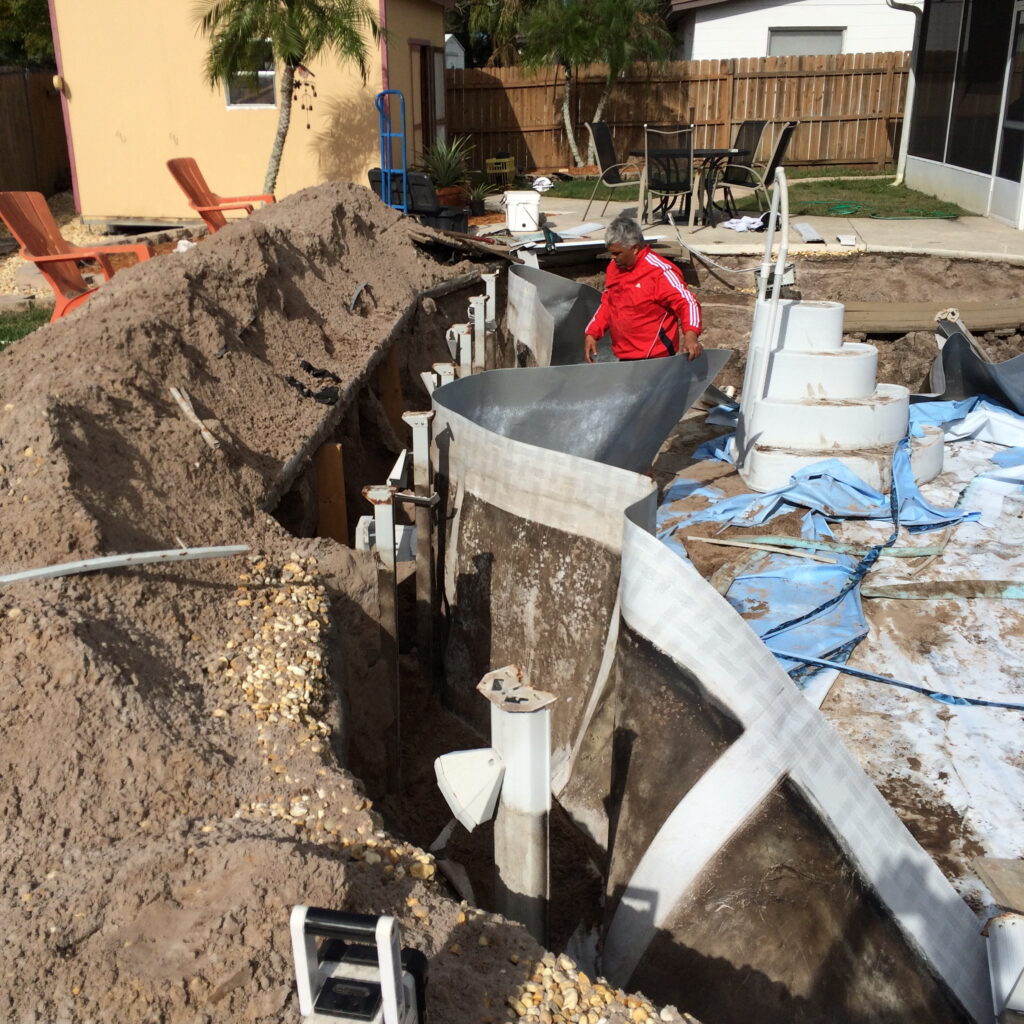
It has become very popular to sink above-ground pools in the ground partially. With that, there can be issues when changing the liner.
This is because, in order to change the liner, you have to drain the pool. And draining a pool that is partially in the ground can cause cave-in problems.
8 Is the bottom flat or deep center/end
Most above-ground pools have flat bottoms, but not all.
If your pool has a deep center or deep end, this will make the liner change job considerably harder to do. This is because standard liners are made for flat bottoms.
Setting the liner for a pool with a deep end/center requires some extra experience so there aren’t a bunch of nasty wrinkles in the bottom.
9. What type of liner is on the pool?
There are four types of liners that can be in a metal-walled above-ground pool. Knowing which type will help determine what it will take to do the job.
NOTE: I usually recommend people change their overlap and beaded liners to unibead/J-hook type.
NOTE: If you are replacing with an overlap-type liner, check the condition of the coping strips. Coping strips are used only with overlap liners. They may need replacing.
10 .Was the skimmer or return fitting leaking?
The most common place an above-ground pool leaks is where the skimmer and return fitting connects to the wall of the pool.
If your skimmer and/or return was/is leaking, you may want to consider replacing it with new. This may make the job slightly harder.
And even if you don’t need to replace the skimmer box and/or return fitting, you want to make very sure that they don’t leak with the new liner.
11. Is there any rust anywhere?
Rust or corrosion is the number one killer of above-ground swimming pools. In some cases, if there is bad rust, it’s not worth changing the liner as the pool may fail soon after and you would be out the cost of the liner change.
Check for rust everywhere on the wall of the pool. This is the worse place for rust. Also, access any rust on the frame of the pool. If the top rails are too rusty, you may want to get replacements for them. And liner change time is an excellent time to change these rusty parts.
12. Does the pool have a main drain?
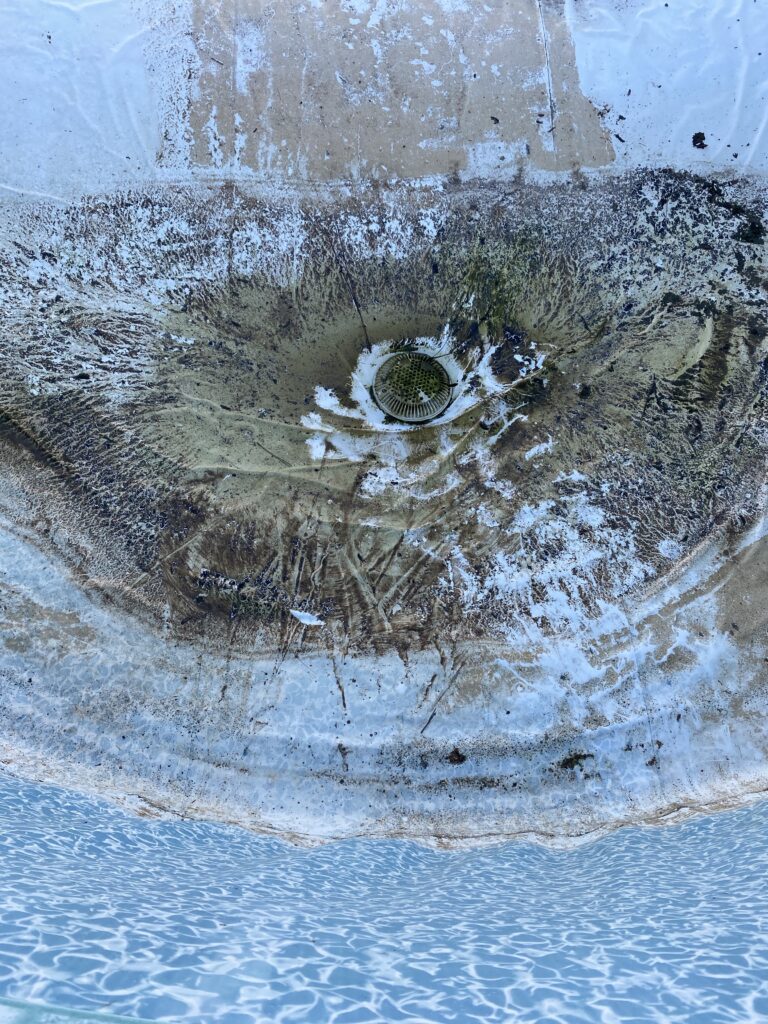
Main drains scare DIYers. They get worried about them leaking when replacing the liner. This is a valid concern for anyone who has never worked with a main drain.
Main drains get accused of leaking way more than they actually leak. There is one way that they often leak, and the mistake does happen when the liner is changed.
ORDERING THE LINER – HOW TO MEASURE THE POOL’S SIZE
Using a tape measure, measure from the inside of the wall to the inside of the wall across the pool in at least two cross spots. This will give you the size of the pool.
The number won’t be the exact size of the pool, but it should be close. As an example, If your pool is round and you get a measurement of 24’, 2”, then it’s a 24’ round pool.
If your pool is an oval, measure the long side and the short side to get your number. The long sides of most ovals are wavy(scalloped). Most times, it’s the shortest measurement that is the official width of the oval.
Find the bottom track of the pool. (You may have to dig down to find it). Using a tape measure, measure from the bottom track up to the top of the wall. The top of the wall will be found UNDER the top rail. This will give you the height of the pool.
You will need the pool’s dimension size and wall height when ordering a liner.
Knowitall advice: Buy a quality liner. They last two to three times longer on average.
TOOLS FOR CHANGING AN ABOVE GROUND POOL LINER
- Utility knife
- Leather gloves
- WD 40 (or similar penatrant)
- Ladder
- Square-headed shovel (preferably with a sharp edge)
- Concrete come-a-long rake
- Small metal rake
- 4′ wide landscaper’s rake
- Cordless drill (with 5/16 hex head fitting and #3 phillips head fitting)
- Large flathead screwdriver or prying tool
- Hammer
- Large channel-lock type wrench
PROFESSIONAL TIPS FOR CHANGING AN ABOVE GROUND POOL LINER (IN CHRONOLOGICAL ORDER)
Most of these tips won’t apply to ALL above-ground pools. Variables like old age, rust, deep centers/ends, semi-inground, attached decks, and poor initial installation can affect the usage of some of these tips.
1 Drain the pool
Some will really stress about how to drain their pool. Just take your pool pole and poke some holes in the bottom of the pool. The water will slowly drain into the earth with no issues.
2 Remove the old liner
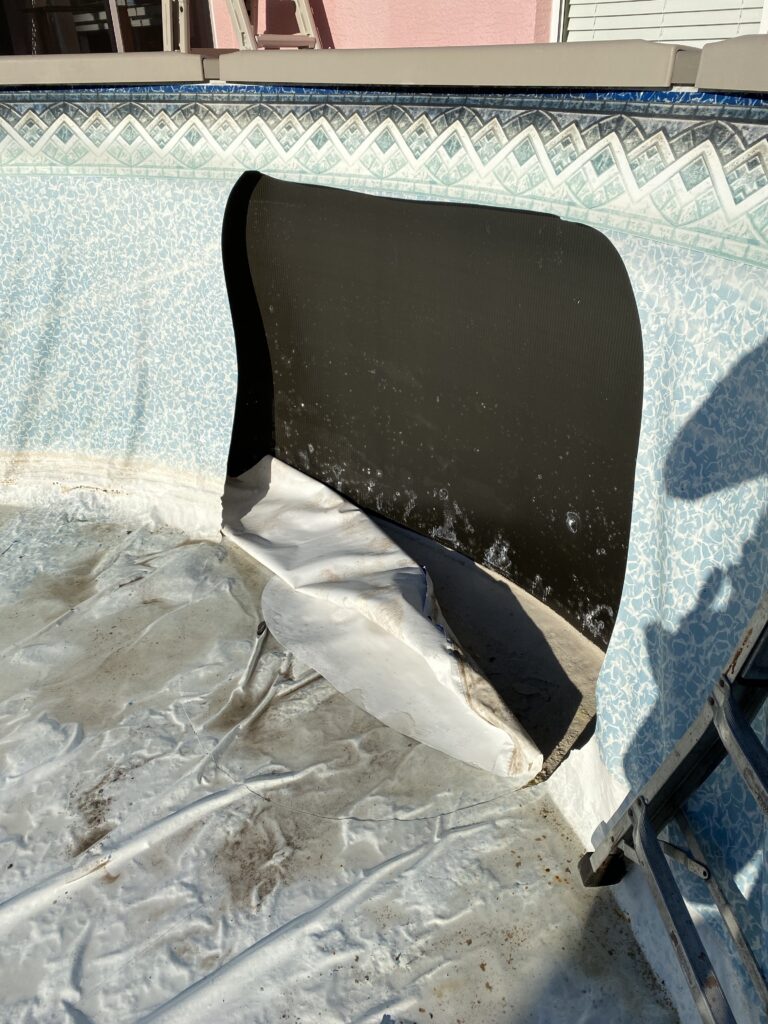

Using a utility knife, cut the old liner out into pieces. Throw the pieces over the wall and out of the pool. Make the pieces a manageable size.
3 Remove the top caps
Knowitall Tip: Wasps don’t fly well in the morning or during cold weather. I recommend removing the top of the pool in the early morning.
- Be careful until you figure out how to take them off – They can break if resin(fancy name for plastic).
- If a deck is in the way, do what it takes to remove caps – Caps can be screwed in from under the top rails. If you have a deck in the way, you’ll have no choice but to get to them any way you can.
- Be aware of wasp nests, frogs, and spiders – They love to make homes under the top caps.
- Keep track of top caps – Place each top cap at the bottom of the upright that they came off of. This way you won’t lose one.
- Spray screws with WD-40 – Once the caps are off, you’ll see the screws that hold the top rails. Spray them now, remove them a little later. If the deck is in the way, do what it takes to remove caps.
4 Re-smooth the pool bottom
While allowing the screws holding the top rails to soak in the WD-40, you can start working on the bottom.
A Rebuild the earth coving – Access your coving. If washed away or looking bad, add more earth to it. Tamp with a concrete come-a-long tool, tamper, or your foot all the way around and re-smooth using the back of a small metal rake.
You can use some of the earth from the pool’s bottom to re-build the coving. Scrape the pool’s bottom with your square-head shovel, concrete come-a-long tool, or rake to get some dirt AND at the same time make the bottom smoother. If the earth is too hard, then buy and use sand.
If existing foam coving, make sure it’s in good shape everywhere. Replace if needed.
B Remove all roots – Any roots that have grown next to the liner should be raked or cut out.
C Use 4’ landscape rake to smooth – Aluminum 4’ wide landscape rakes are available at big box hardware stores. They are great for making the pool bottom flat. If you can’t get one, use whatever has the widest straight edge that you can get.
D Add sand if needed – If your earth bottom is hard and bumpy and you can’t easily scrape it smoother, then buying some bags of regular sand and spreading it over the dips and ruts is the answer.
E If existing liner guard, peel back half at a time and work the earth smooth. May not be re-useable – Existing liner guards can be a pain to deal with. It’s usually best to keep it in place by peeling back half of it, working the earth underneath to smooth, then replacing and peeling back the other half to do the same.
F Spray down your bottom with the water hose and let sit while you do the next step
5 Remove the top rails
At this point, you’ve worked on the bottom some, but not all. It’s time to take off the top rails.
A Place each rail on the outside of the pool close to where it came off (if you can) – It’s easier to keep each top rail where they were positioned around the pool. Keep track of where they came off by placing each removed top rail on the ground around the pool directly beneath where it was.
B If screws won’t come off– Some screws will be severely rusted and won’t come out. Good times ahead! Here are some tips.
B1 Spray with penetrant twice and wait.
B2 Use hammer and flat head to pry loose – Sometimes, a little brute force helps. Place the flat-head screwdriver under or next to the rusty screw and beat it with a hammer. This may loosen it enough to unscrew out.
Also, if the screw is loose but won’t come out, pry the screwdriver under the screw head and try to unscrew it. This may prevent it from just spinning and start to come out.
B3 If heads are stripped, use an adjustable wrench to grab and unscrew – Fittings are useless if the head of the screw is stripped out. With that, take an adjustable wrench or needle-nose pliers and grab the side of the screw head firmly and try to unscrew it that way. This will take some patience.
B4 If heads break off, use a self-tapping screw when replacing – Some screw heads will sheer off. At that point, you’re screwed. Don’t worry. Let it go and plan on using a self-tapping screw when you replace the top rail.
C If resin top rails, you may have to break the plastic around the screw to free. Screw in a different spot when replacing – Sometimes you will have no choice but to break the top rail around the screw. Don’t worry about it. You won’t see the break as it will be covered by the top cap when the pool goes back together.
6 Remove top connector plates
To prevent these from getting lost, set them on the ground with the top caps all the way around the pool. Beware of wasps nests at this stage. They can be hidden under a connector plate
7 Remove stabilizer bars(top track)
You should have a strip of liner left around the top of the pool from where you cut the liner out in pieces. It’s time to remove that.
Remove the stabilizer bars one at a time, remove the top of the old liner, then replace the bar(top track). Repeat until the liner is off the wall all the way around and the bars are replaced.
NOTE: Replacing the stabilizer bars will keep the wall rigid and help prevent it from falling over (if windy) and when hanging the new liner up to the wall.
8 Fasten spring clips to the top of each upright.
NOTE: It may be hard to find spring clips that are wide enough to grab the uprights to the top of the wall. If you cannot find them, use spring clips that can clamp to the wall only. You will need them later when installing the new liner.
Attaching spring clips to each upright do two things. One is that it helps keep the wall up since it is clipping the wall to the upright. The other is that it will be used to temporarily hold the new liner to the top of the wall so you can set the liner in place.
9 Finish re-smoothing the pool bottom
Earlier, you worked on the pool bottom. You re-built the coving and smoothed out the bottom by either scrapping some of the earth or adding sand and then ran the rake upside-down along the bottom.
Your bottom should be close to ready. Run your (hopefully 4’ wide landscape) rake upside down in a circular motion from the middle outward, then run it across back and forth in different directions.
As you run the rake upside down, remove any rocks or debris that you run into. Scrape high points and fill in low points to make the bottom smooth. Wet the bottom down and repeat as much as you need to.
NOTE: Wetting down the earth removes air, which allows you to make the earth flatter.
10 Remove skimmer and return fitting
Remove the (usually) 18 screws from the faceplate of the skimmer. Take off the faceplate. Inspect the skimmer gaskets.
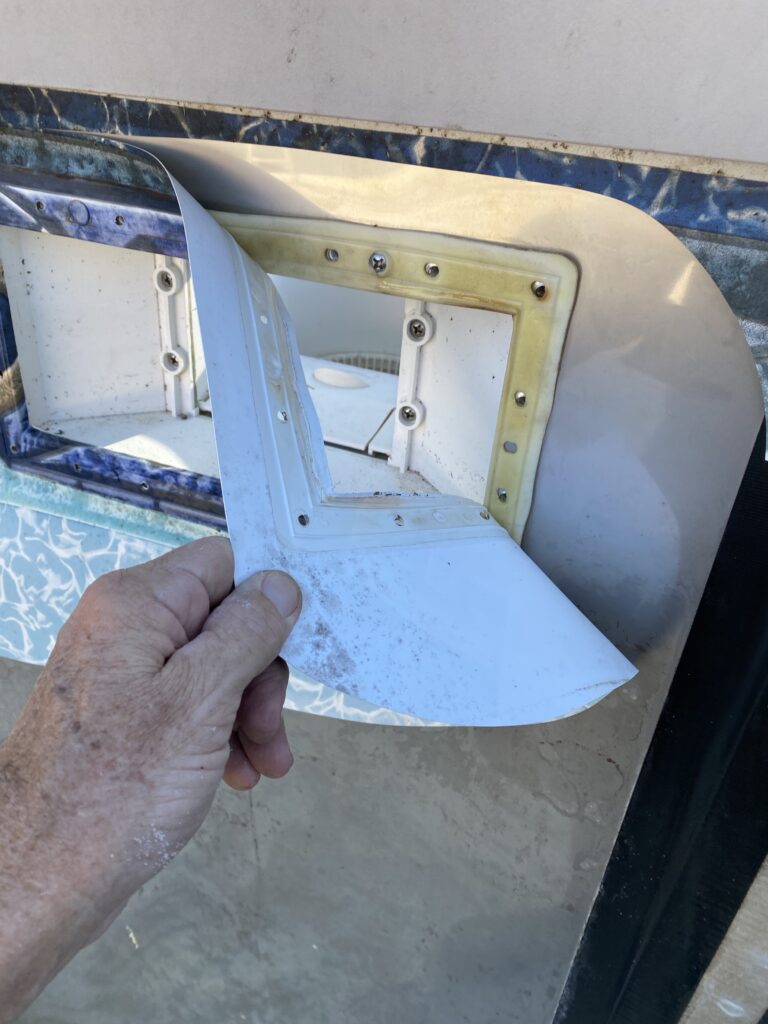
If the skimmer gaskets look bad, replace them with new ones. Don’t mess around with questionable gaskets. You don’t want to do all this work and have a leak because you didn’t want to spend a few more bucks.
Remove the return fitting using large channel locks. The nut on the outside of the pool comes off.
Same thing with the return gaskets. If they look bad, replace them.
11 Place the new liner inside the pool (still in the box)

This will ensure that the liner won’t get a tear or hole in it somewhere in your yard.
12 Make sure it’s a warmer day or very sunny when setting the new liner.
Liners are easier to work with when they are warm.
13 Get inside the pool, take out of the box, and unfold the liner.
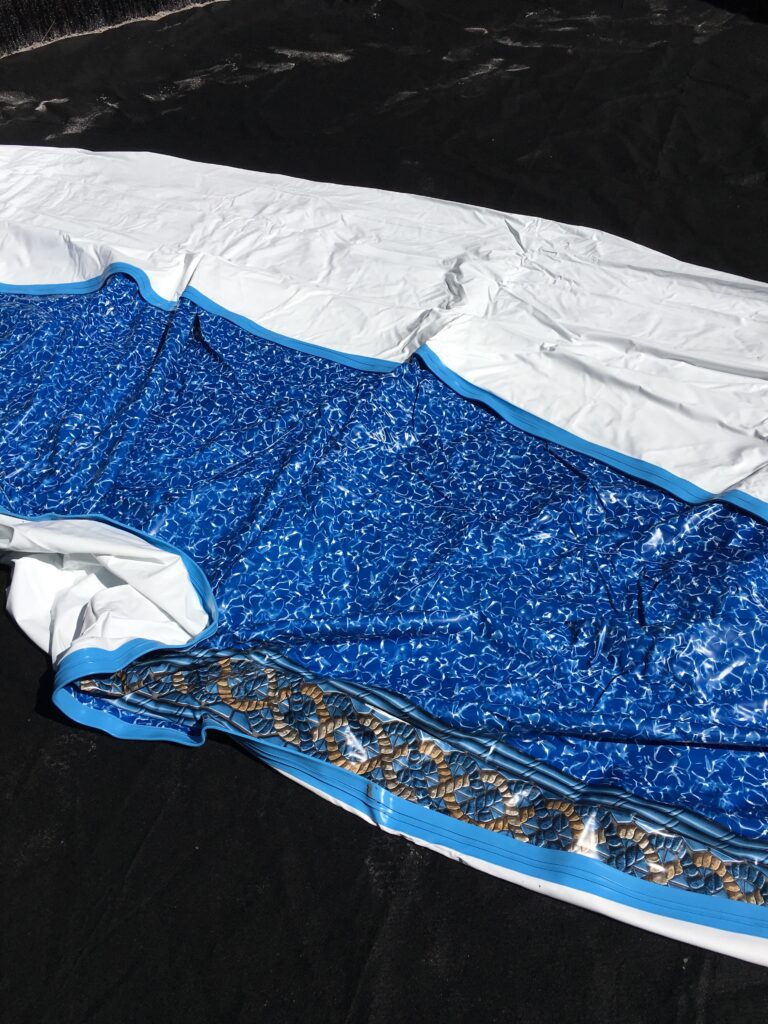
A Find the seam in the liner that attaches the wall piece to the floor piece. If the pool is round, then the seam will be round. If the pool is an oval, then the seam will be an oval.

B Use that seam to place the liner correctly. Set that seam evenly along the coving area(where the floor meets the wall).
14 Hang the liner up on the wall

A Lift the wall/side part of the liner up and temporarily clip to the pool wall using the spring clamps.
B Once up everywhere, use your foot and adjust the (round or oval) seam to the wall making it as evenly from the wall all the way around as possible.
Note: If overlap type liner, pull liner OVER the wall and clip with spring clamps.
15 Start filling the pool
A As the bottom covers with water, pull the liner outward from the center – Starting from the very center of the bottom, pull the liner outward (in every direction towards the wall) to remove wrinkles. As the circle you pulled gets bigger, continue to pull out any wrinkles. Pull the liner all the way around to the wall. There will now be no wrinkles on the bottom of the pool.
16 Attach the liner to the wall
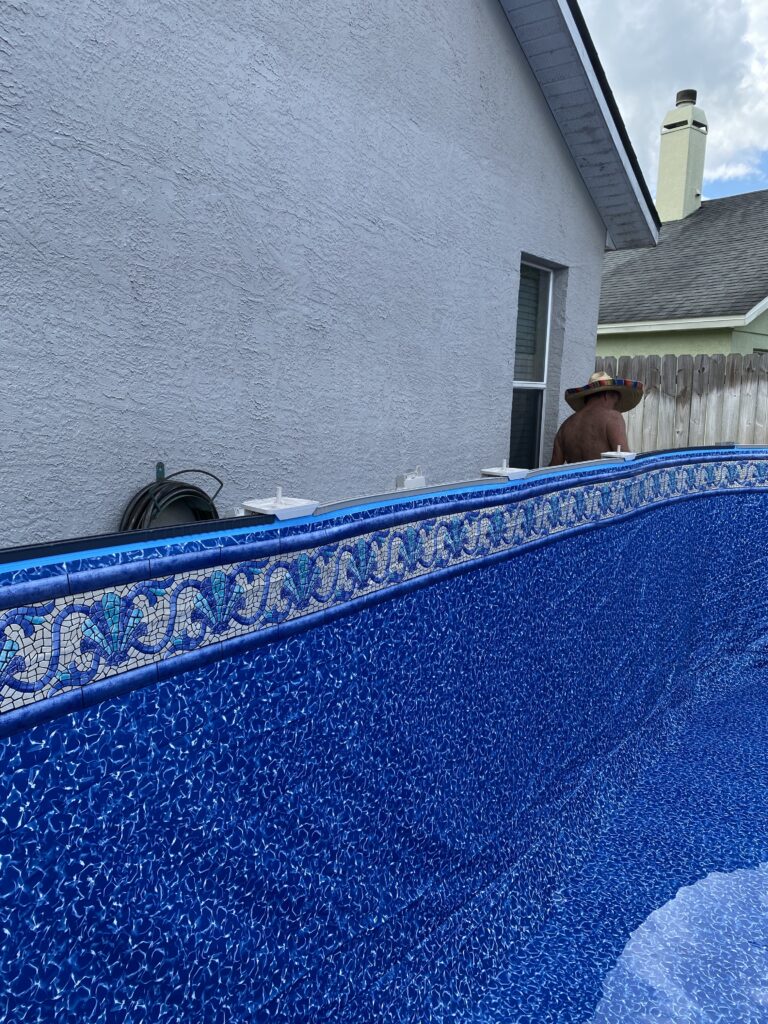
If j-hook type, remove stabilizer bars (top rails) one piece at a time, attach j-hook to top of the wall, replace stabilizer over J-hook. NOTE: You may need a rubber mallet or hammer to tap them in place over the J-hook.
A If excess liner at the top of the pool, bunch up the j-hook as much as you can when attaching
B If the top of the liner is tight, pull as much of the j-hook horizontally as you can to stretch over the wall
Note: You don’t want to end up with excess liner or not be able to pull all of the j-hook over the liner because too tight.
If overlap type, pull enough of the liner over the wall to make it slightly smaller than the pool (This will allow the liner to stretch perfectly to the wall as it fills with water.
TIP: Use your foot to gauge how tight the liner is to the wall. Press the liner against the wall at the bottom(just above the coving) with your foot.
A Remove the stabilizer bars one at a time, attach the pieces of coping strips over the liner (on top of the wall), then replace the bars (top track) over the coping strips. Repeat until all coping strips are covering the liner and the stabilizer bars are covering the coping strips all the way around the pool.
If beaded-type liner, begin feeding the bead of the liner into the channel ( the channel will be your pool’s stabilizer bars (top track) with a channel hanging down inside the pool.
A Insert the bead into the channel at several places around the pool just a couple of inches wide. This will lessen the likelihood of having excess or not enough bead in a particular area.
B Continue to insert more of the bead (on top of the liner) in the channel in different spots around the pool. Eventually, all of the bead will be in the channel.
NOTE: If there is excess bead material, feed the bead very tightly into the channel. This will use up bead horizontally. Conversely, if the bead is very tight, pull the bead horizontally while feeding into the channel. This will stretch the bead some and give you more bead to work with.
17 Re-attach the top connector plates to the uprights.
These will go on just how they come off. There are many different designs to this, so remembering how they came off is all that I can tell you. Lol
18 Re-attach the top rails to the connector plates

A Line up the screw holes exactly where they were when you took it apart (this is why you placed each top rail at the outside of the pool in front of where it was– to ensure the top rails go in the same place that they came off.)
B Replace any screws that were too rusty or stripped with new, quality stainless steel screws
NOTE: Some “corrosion-resistant” screws still rust quickly with above-ground pools. Using stainless steel screws costs more, but will always unscrew for the next time you have to change the liner.
C Replacement screws should have the same type of head as the others – This will make it easier when changing the liner next time.
D If any holes cannot be reused, used stainless or galvanized self-tapping screws to make new holes and connections.
E If some resin top rails were broken at the screw point, screw down next to where there were attached with self-tappers.
19 Re-attach top caps
A If old screw holes cannot be used, use self-tapping screws and attach any way you can.
20 Wait for the pool to fill to at least halfway before attaching the skimmer and return fitting.
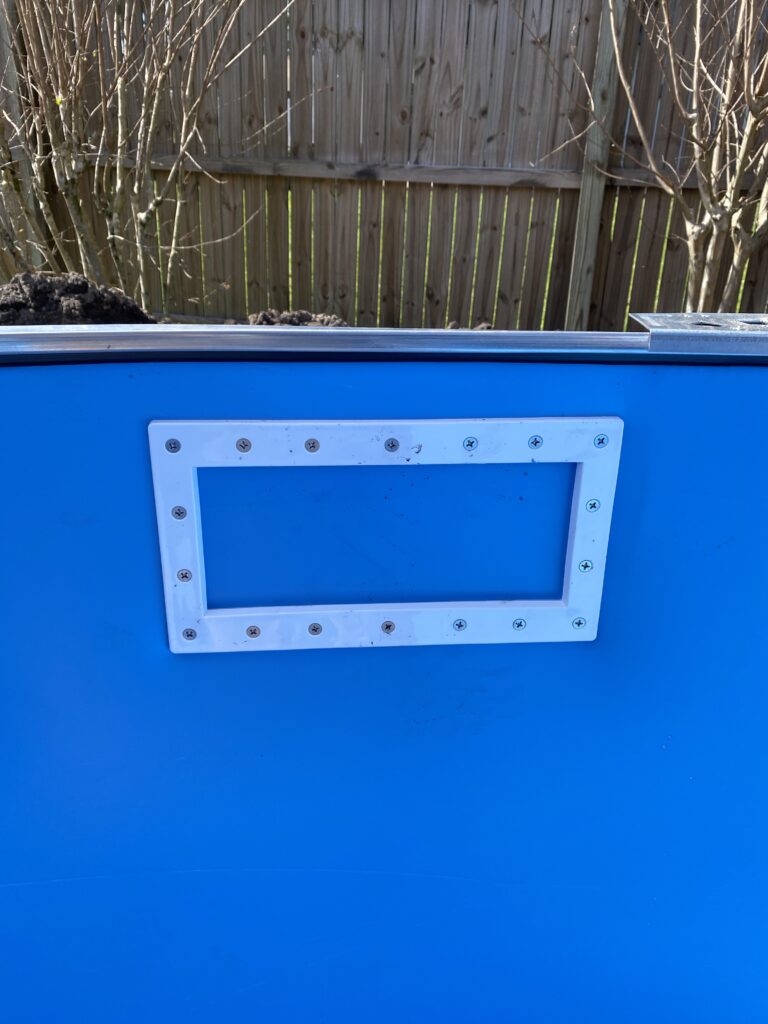
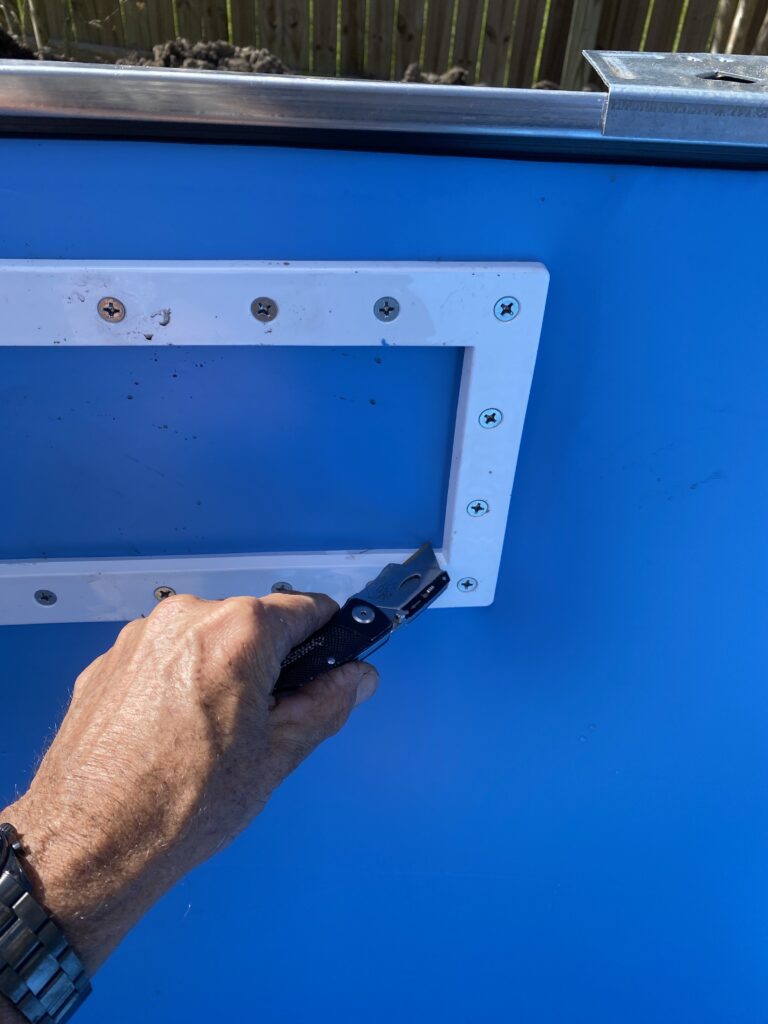
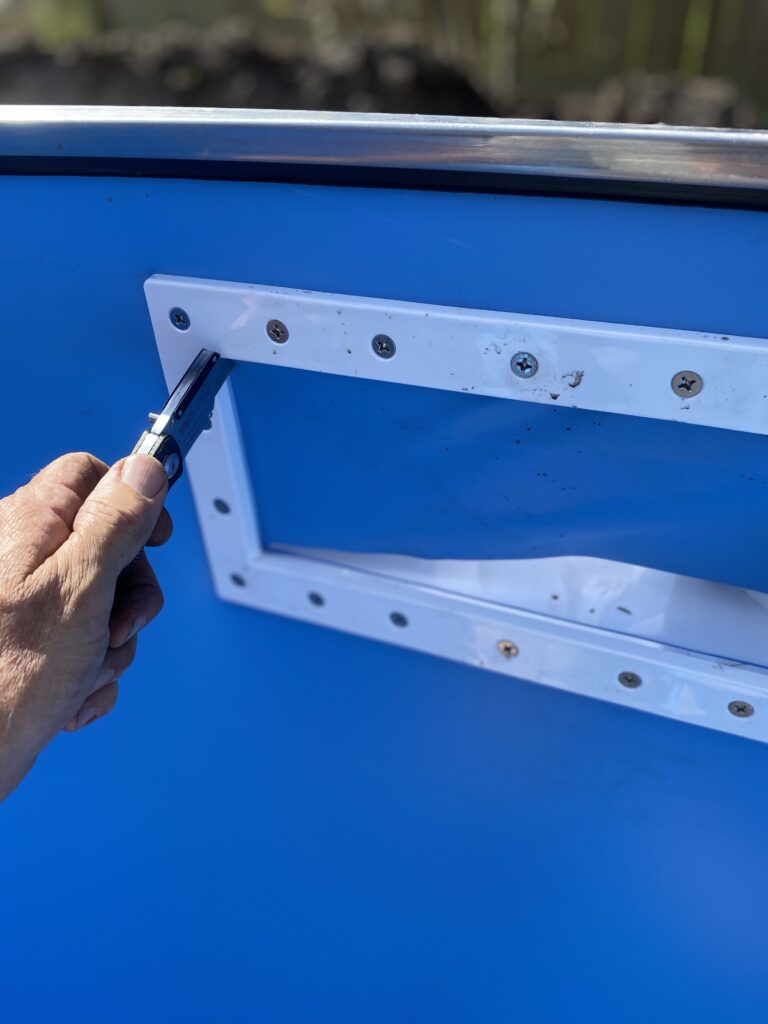
A It’s best to be in the pool when attaching the skimmer
B The liner will be in place (because the pool will have water in it)
C Using the faceplate screws, screw in the faceplate and gasket(if 2 piece) to the wall on the inside to the gasket and skimmer box on the outside.
D Hand Tighten screws very tight. Do not use silicone.
E If old gasket/s look bad, buy new and replace them.
F Once all screws (usually 18 of them for a widemouth-type) are tight, cut the liner piece out on the inside opening.
21 Place return fitting (with nut removed) with one gasket in front of the wall on the inside and press into the opening.
A Using a sharp utility knife, cut the liner in an asterisks type pattern on the outside of the wall.
B It may be best if one person is pressing the fitting through the opening from the inside of the pool and another make the asterisks-like slices to the liner on the outside of the pool
C When a few cross slices are made, push the fitting through the wall and in place. Excess liner will be sticking out on the outside of the pool and around the fitting threads.
D With the fitting in place, cut the excess pieces of liner around the fitting on the outside of the pool
E Replace the two gaskets (usually one rubber, one paper) and then the ring.
F Tighten the ring on the outside using a large crescent-type wrench. Tighten fairly tight. You shouldn’t need any silicone.
G Attach skimmer and return to the pump and filter as before. Use a coupling if you have to cut any PVC.
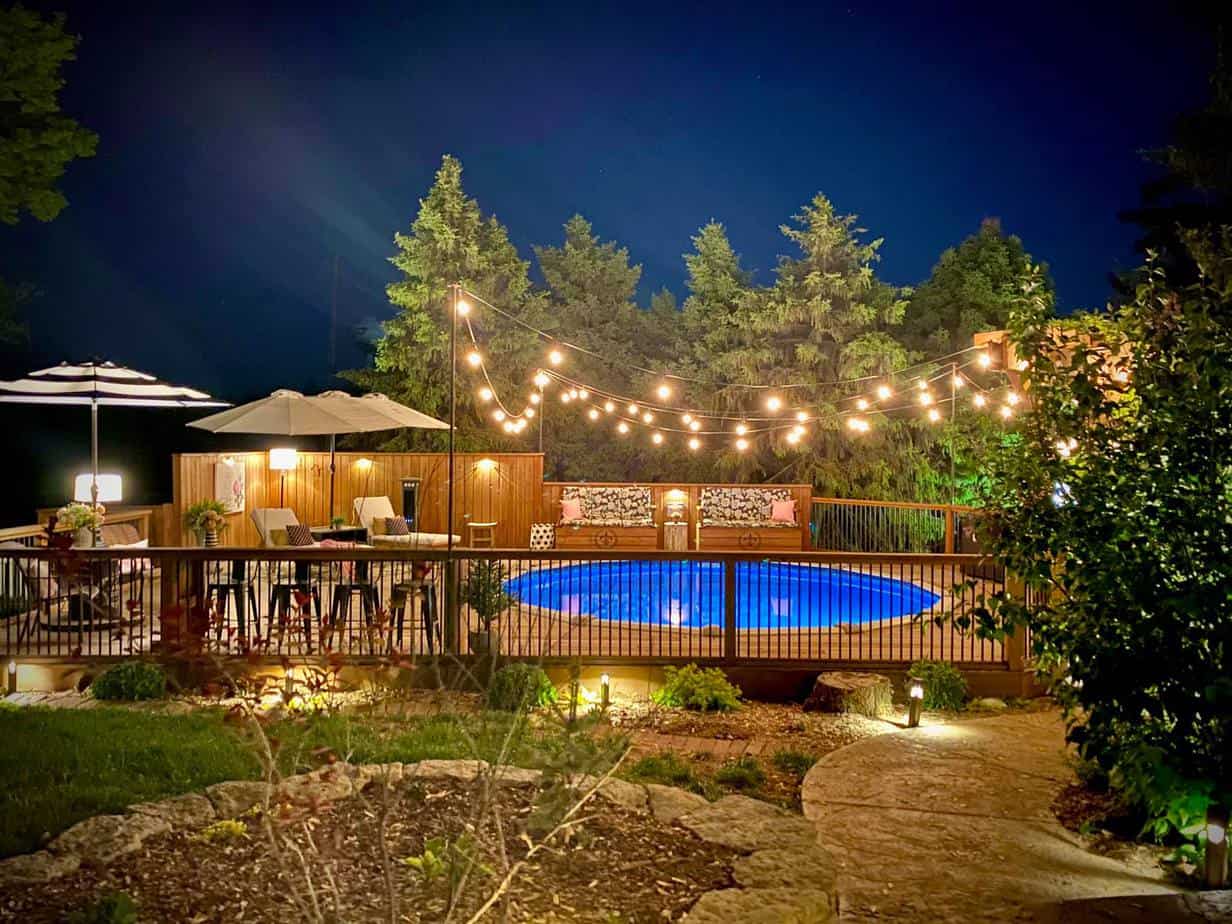
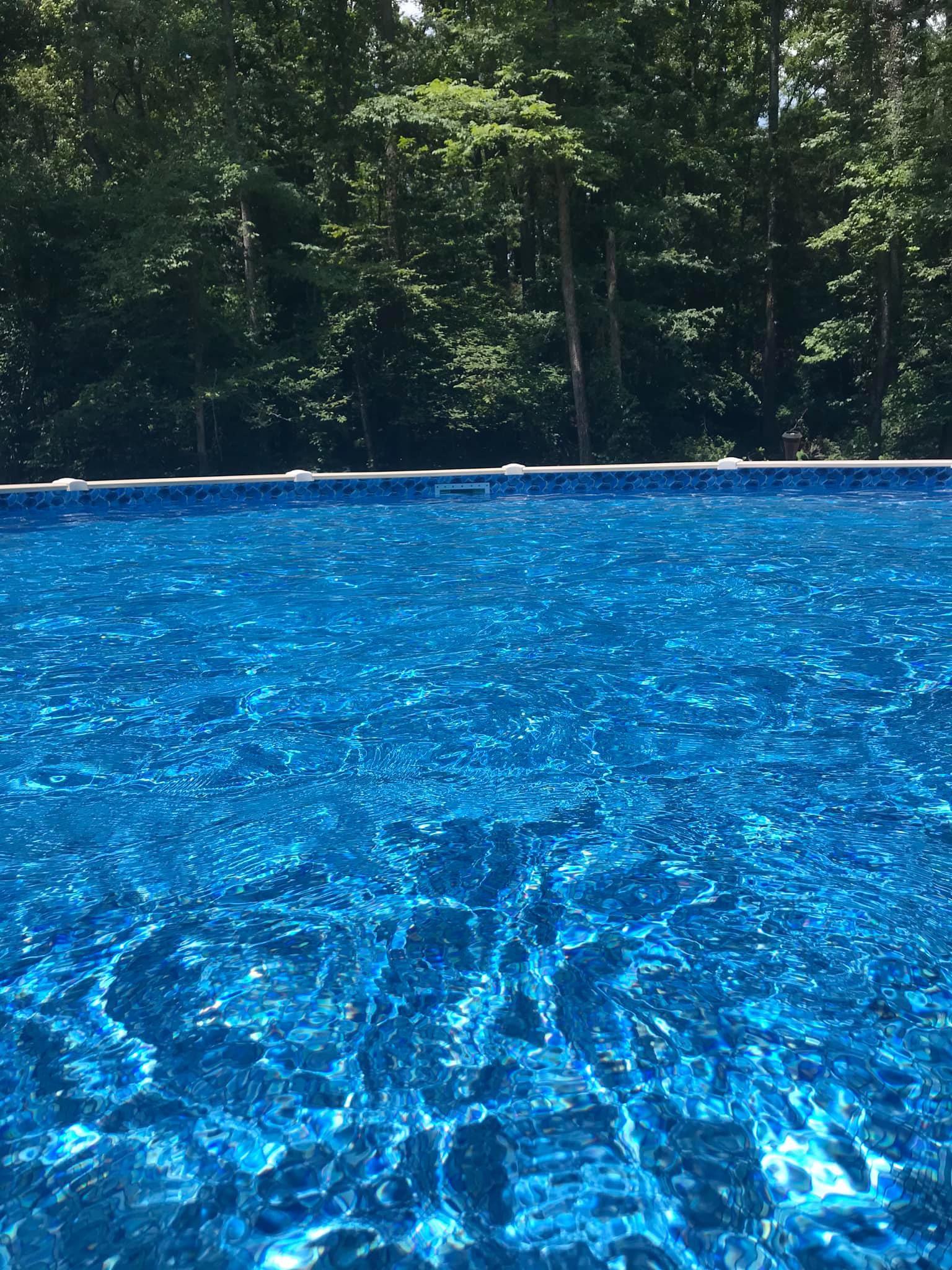
Dan,
We are having some trouble with our overlap liner, not overlapping enough! We installed a week ago started hoses and it started slipping out of the coping strips. We drained all water, started over working on north, south, east and west moving the bottom seem along the bottom floor, using a shop vac sucked all walls in. Still looks like it might not work. ( not enough to pull over on the north end)
Pool is 33×54 our 3rd above ground however the other two were 48 inch walls so we had plenty of overlap this is the first 54 inch wall and you just don’t get a lot of extra! It’s made in USA I seen one of your posts about no liner from China. We’re in Kansas so we’re plenty warm/hot only filling above 70 and sun and shut off hose at dark time. We think we will need to work on the track, possibly during install we got the circle off?
Any other tips for a 54 inch overlap liner we appreciate!
Hi. You shouldn’t have this issue, BUT I have had this issue maybe twice several years ago. The culprit turned out to be that the liner was too short. A standard overlap liner should have 60 inches (five feet) of material on the sides of it measuring from the round bottom seam up to the top of the liner.
My two that didn’t work had much less wall material than 60 inches. Measure that to make sure.
Otherwise, the liner either shrunk because it was filled with water and then drained OR the pool is severely out of round.